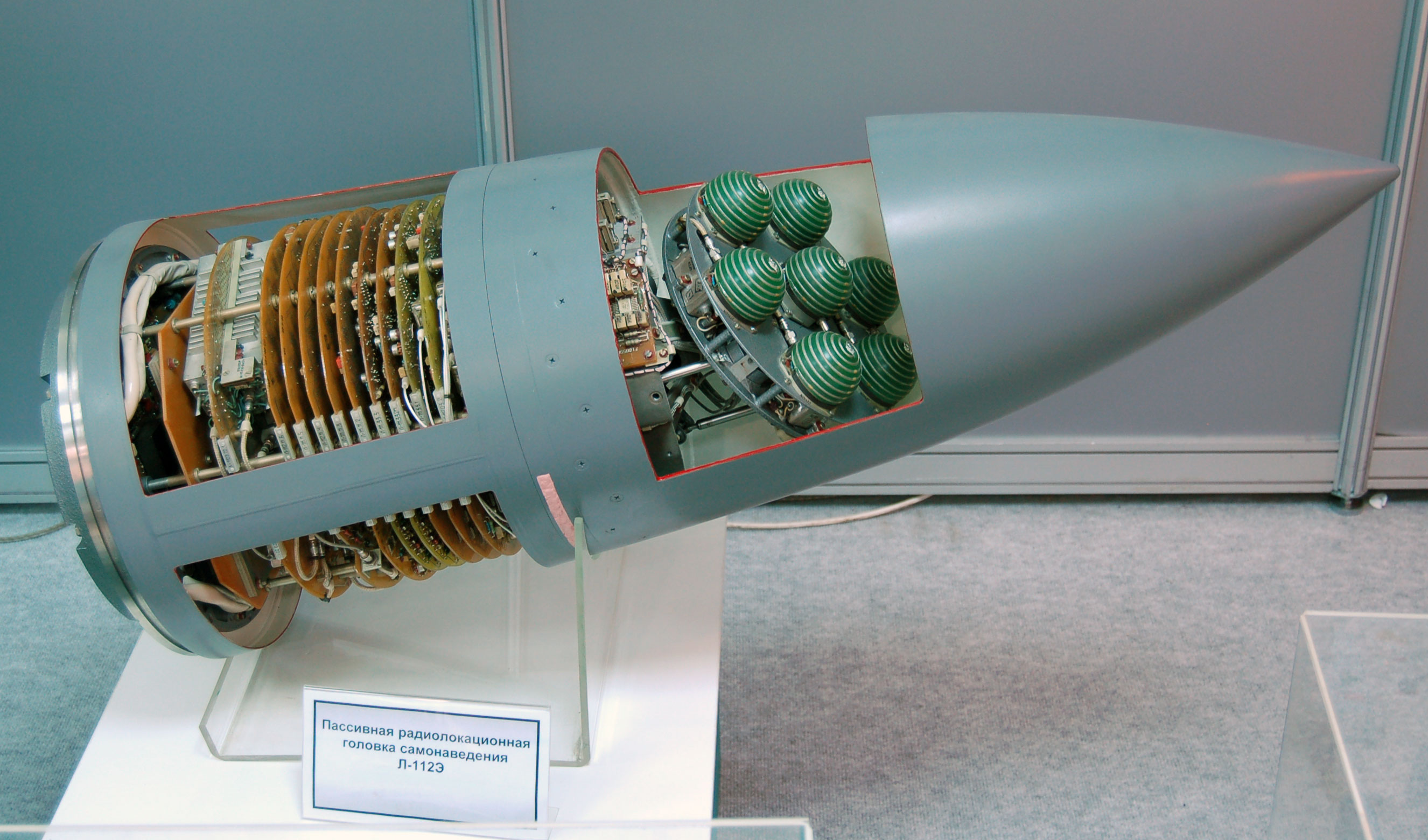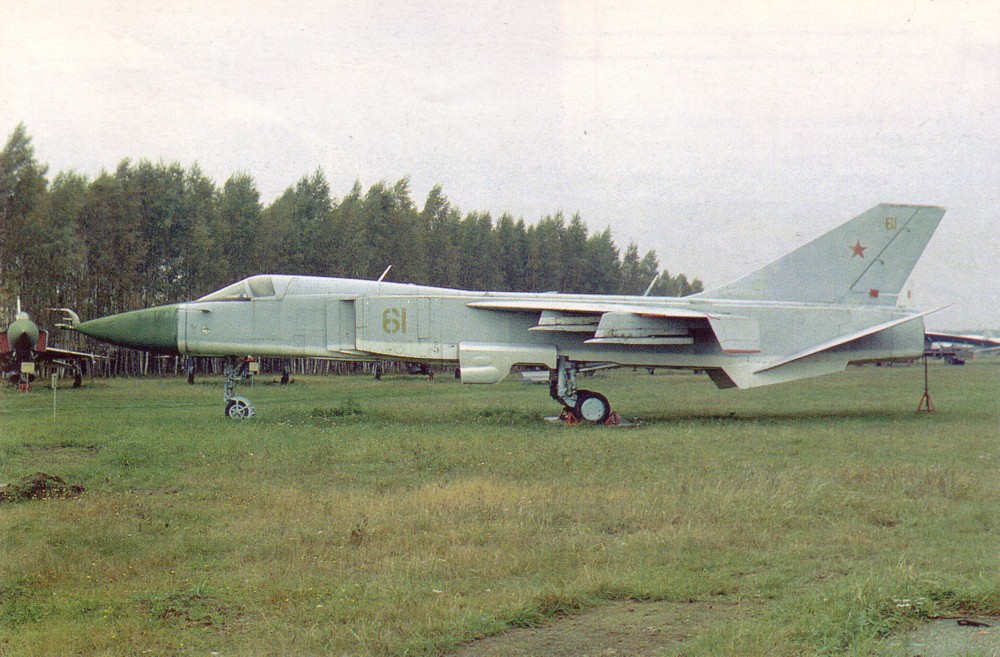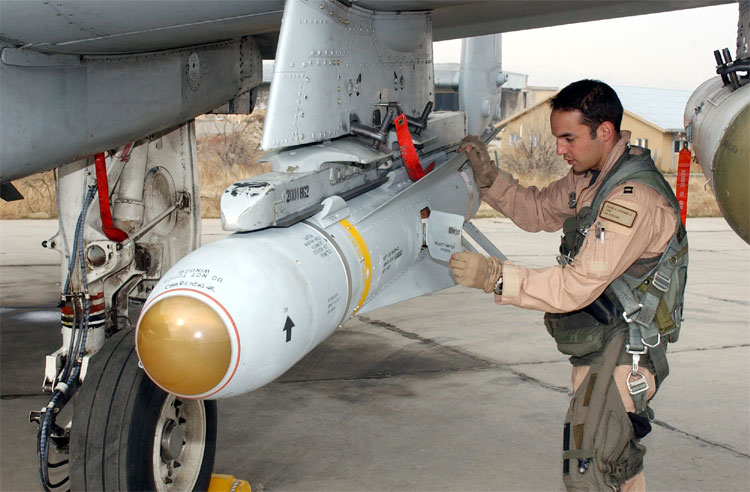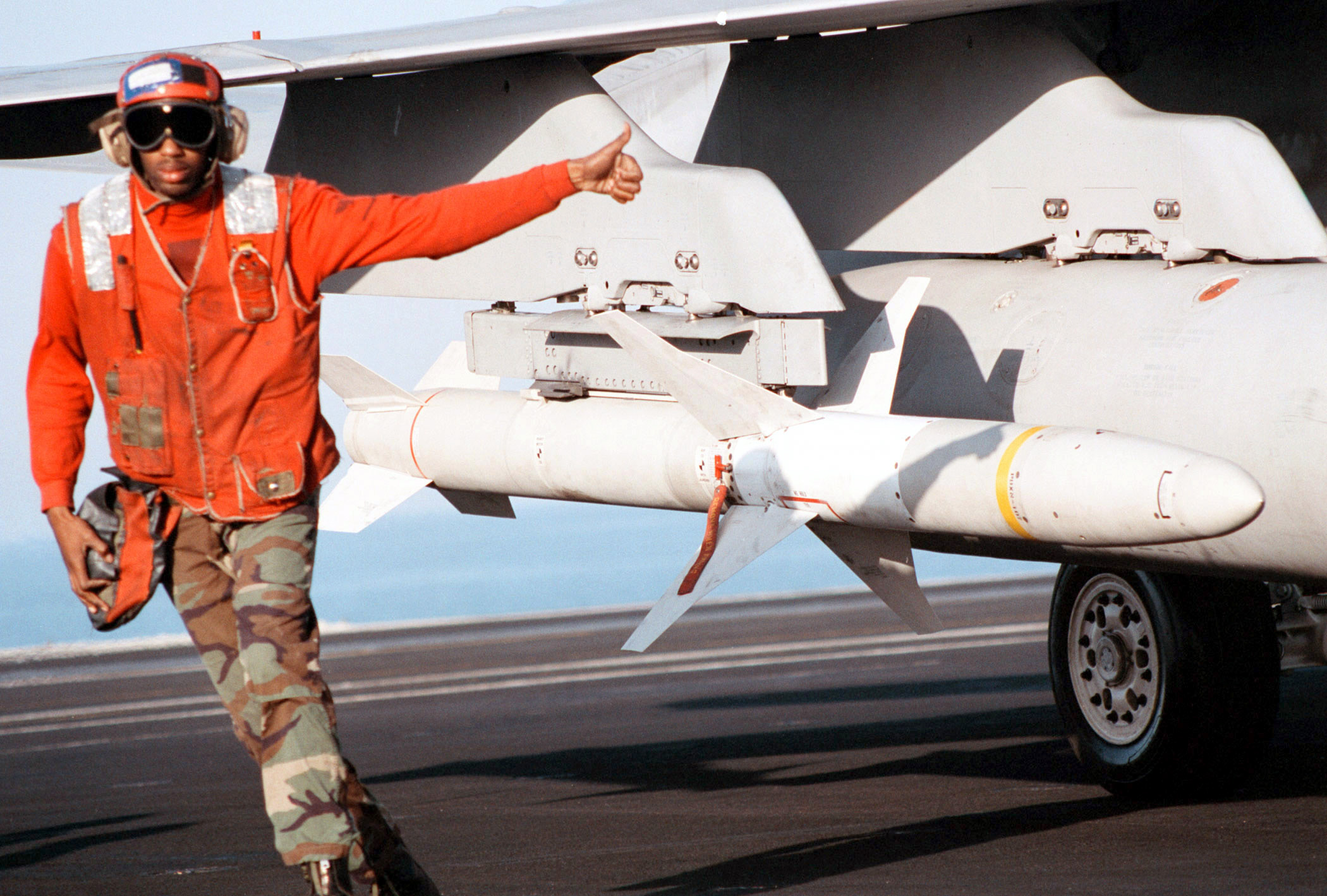|
Kh-31
The Kh-31 (; AS-17 'Krypton') is a Soviet and Russian air-to-surface missile carried by aircraft such as the MiG-29, Su-35 and the Su-57. It is capable of Mach number, Mach 3.5 and was the first supersonic anti-ship missile that could be launched by tactical aircraft. There are several variants; the Kh-31 is best known as an anti-radiation missile (ARM) but there are also anti-ship and target drone versions. There has been talk of adapting it to make an "Airborne early warning and control, AWACS killer", a long-range air-to-air missile. Development The proliferation of surface-to-air missiles (SAMs) has made the Suppression of Enemy Air Defences (SEAD) a priority for any modern air force intending offensive action. Knocking out air search radars and fire control radars is an essential part of this mission. ARMs must have standoff (missile), sufficient range that the launch platform is out of range of the SAMs, high speed to reduce the risk of being shot down and a seeker that can ... [...More Info...] [...Related Items...] OR: [Wikipedia] [Google] [Baidu] |
Suppression Of Enemy Air Defences
Suppression of Enemy Air Defenses (SEAD ), also known in the United States as "Wild Weasel" and (initially) "Iron Hand" operations, are military actions to suppress enemy surface-based anti-aircraft warfare, air defenses, including surface-to-air missiles (SAMs), anti-aircraft artillery (AAA), and related systems such as early-warning radar and command, control and communication functions. Suppression can be accomplished by physically destroying the systems or by disrupting and deceiving them through electronic warfare. In modern warfare, SEAD missions can constitute up to 30% of sorties launched in the first week of combat and continue at a reduced rate through the rest of a campaign.Tucker, Spencer C. (Editor), ''The Encyclopedia of Middle East Wars: The United States in the Persian Gulf, Afghanistan, and Iraq Conflicts'', ABC-CLIO, 2010, pp. 61–62. One-quarter of American combat sorties in recent conflicts have been SEAD missions. They are generally associated with aircraf ... [...More Info...] [...Related Items...] OR: [Wikipedia] [Google] [Baidu] |
Su-24
The Sukhoi Su-24 (NATO reporting name: Fencer) is a supersonic, night fighter, all-weather tactical bomber developed in the Soviet Union. The aircraft has a variable-sweep wing, Twinjet, twin engines and a side-by-side seating arrangement for its crew of two. It was the first of the USSR's aircraft to carry an integrated digital Nav/attack system, navigation/attack system. The Su-24 started development in the early 1960s and first flew in 1967. It entered service in 1974 and production ceased in 1993. It remains in service with the Russian Aerospace Forces, Syrian Air Force, Ukrainian Air Force, Algerian Air Force and various other air forces to which it was exported. Development Background One of the conditions for accepting the Sukhoi Su-7, Sukhoi Su-7B into service in 1961 was the requirement for Sukhoi to develop an all-weather variant capable of precision air strikes. Preliminary investigations with ''S-28'' and ''S-32'' aircraft revealed that the basic Su-7 design was to ... [...More Info...] [...Related Items...] OR: [Wikipedia] [Google] [Baidu] |
Active Radar Homing
Active radar homing (ARH) is a missile guidance method in which a missile contains a radar transceiver (in contrast to semi-active radar homing, which uses only a passive radar, receiver) and the electronics necessary for it to find and track its target autonomously. The NATO brevity code for an air-to-air active radar homing missile launch is fox (code word), Fox Three. Advantages There are two major advantages to active radar homing: * As the missile is tracking the target it is going to be much closer to the target than the launching platform during the terminal phase, thus the missile's tracking can be much more accurate and better resistant to electronic countermeasures. Active radar homing missiles have some of the best kill probability, kill probabilities, along with missiles employing track-via-missile guidance. * Because the missile is totally autonomous during the terminal phase, the launch platform does not need to have its radar enabled at all during this phase, an ... [...More Info...] [...Related Items...] OR: [Wikipedia] [Google] [Baidu] |
Su-35
The Sukhoi Su-35 (-35; NATO reporting name: Flanker-E/M, occasionally nicknamed "Super Flanker") is the designation for two improved derivatives of the Su-27 air-defence fighter. They are single-seat, twin-engine, supermaneuverable, 4.5 generation air superiority fighters, designed by the Sukhoi Design Bureau and built by Sukhoi. The type was originally developed by the Soviet Union from the Su-27 and was known as the Su-27M. It incorporated canards and a multi-function radar giving it multi-role capabilities. The first prototype made its maiden flight in June 1988. Following the dissolution of the Soviet Union Sukhoi re-designated it as the Su-35 to attract export orders. Fourteen aircraft were produced and used for tests and demonstrations; one example had thrust-vectoring engines and was in turn redesignated the Su-37. A sole Su-35UB two-seat trainer was also built in the late 1990s that resembled the Su-30MK family. In 2003, Sukhoi embarked on a second "deep" mo ... [...More Info...] [...Related Items...] OR: [Wikipedia] [Google] [Baidu] |
Tactical Missiles Corporation
JSC Tactical Missiles Corporation (KTRV) (, КТРВ) is a major Russian holding company for the manufacturers of military weapons (especially missiles), headquartered in Korolyov, Moscow Oblast. History Tactical Missiles Corporation was founded on the basis of Zvezda-Strela by the Decree of the President of Russia, Decree of Russian President №84, signed on January 24, 2002. Zvezda-Strela was a major designer and producer of military missile systems, and included the Zvezda Experimental Design Bureau (OKB), a serial production design bureau (SKB), the main Strela plant, and machine building plants in Kostroma and Bendery Moldova. It was formerly part of the missile-industry grouping ''Spetstekhnika'' (Special Equipment). The structure of Tactical Missiles Corporation was expanded by subsequent decrees №591 on May 9, 2004 and №930 on July 20, 2007. The holding is sanctioned by New Zealand in relation to the 2022 Russian invasion of Ukraine. It was reported in Septembe ... [...More Info...] [...Related Items...] OR: [Wikipedia] [Google] [Baidu] |
Air-to-surface Missile
An air-to-surface missile (ASM) or air-to-ground missile (AGM) is a missile designed to be launched from military aircraft at targets on land or sea. There are also unpowered guided glide bombs not considered missiles. The two most common propulsion systems for air-to-surface missiles are rocket motors, usually with shorter range, and slower, longer-range jet engines. Some Soviet Union, Soviet-designed air-to-surface missiles are powered by ramjets, giving them both long range and high speed. Missile guidance, Guidance for air-to-surface missiles is typically via laser guidance, infrared homing, infrared guidance, optical guidance or via satellite guidance signals. The type of guidance depends on the type of target. Ships, for example, may be detected via passive radar or active radar homing, which is less effective against multiple, small, fast-moving land targets. There is some cross-over between air-to-surface missiles and surface-to-surface missiles. For example, there was ... [...More Info...] [...Related Items...] OR: [Wikipedia] [Google] [Baidu] |
Su-57
The Sukhoi Su-57 (; NATO reporting name: Felon) is a Twinjet, twin-engine stealth aircraft, stealth Multirole combat aircraft, multirole fighter aircraft developed by Sukhoi. It is the product of the PAK FA (, prospective aeronautical complex of front-line aviation) programme, which was initiated in 1999 as a more modern and affordable alternative to the Post-PFI Soviet/Russian aircraft projects, MFI (Mikoyan Project 1.44, Mikoyan Project 1.44/1.42). Sukhoi's internal designation for the aircraft is T-50. The Su-57 is the first aircraft in Russian military service designed with stealth technology and is intended to be the basis for a family of stealth combat aircraft. A multirole fighter capable of aerial combat as well as ground and maritime strike, the Su-57 incorporates Stealth technology, stealth, supermaneuverability, supercruise, integrated avionics and large payload capacity. The aircraft is expected to succeed the Mikoyan MiG-29, MiG-29 and Sukhoi Su-27, Su-27 in th ... [...More Info...] [...Related Items...] OR: [Wikipedia] [Google] [Baidu] |
MiG-29
The Mikoyan MiG-29 (; NATO reporting name: Fulcrum) is a twinjet, twin-engine fighter aircraft designed in the Soviet Union. Developed by the Mikoyan design bureau as an air superiority fighter during the 1970s, the MiG-29, along with the larger Sukhoi Su-27, was developed to counter U.S. fighters such as the McDonnell Douglas F-15 Eagle and the General Dynamics F-16 Fighting Falcon. The MiG-29 entered service with the Soviet Air Forces in 1983. While originally oriented towards combat against any enemy aircraft, many MiG-29s have been furnished as multirole combat aircraft, multirole fighters capable of performing a number of different operations, and are commonly outfitted to use a range of air-to-surface armaments and precision munitions. The MiG-29 has been manufactured in several major variants, including the multirole Mikoyan MiG-29M and the navalised Mikoyan MiG-29K; the most advanced member of the family to date is the Mikoyan MiG-35. Later models frequently feature impr ... [...More Info...] [...Related Items...] OR: [Wikipedia] [Google] [Baidu] |
Anti-radiation Missile
An anti-radiation missile (ARM) is a missile designed to detect and home in on an enemy radio emission source. Typically, these are designed for use against an enemy radar, although jammers and even radios used for communications can also be targeted in this manner. The earliest known anti-radiation weapon is a variant of the Blohm & Voss BV 246 radar guided bomb.Lepage, Jean-Denis G.G. (2009). Aircraft of the Luftwaffe 1935-1945. McFarland. p. 67. . Home-on-jam As jammers proliferated, a number of existing ARMs such as the AGM-88 HARM was modified to also target jammers as the source of radiation. Jammers also led to the addition of a feature to missiles that usually use a different targeting mode (e.g. active radar homing, semi-active radar homing, GPS), allowing them to switch to an anti-radiation targeting mode when radar deteriorates too much. Some examples are: * JDAM and JDAM-ER, air-to-surface GPS bomb * AMRAAM, active radar homing air-to-air missile * R-77, active ... [...More Info...] [...Related Items...] OR: [Wikipedia] [Google] [Baidu] |
Surface-to-air Missile
A surface-to-air missile (SAM), also known as a ground-to-air missile (GTAM) or surface-to-air guided weapon (SAGW), is a missile designed to be launched from the ground or the sea to destroy aircraft or other missiles. It is one type of anti-aircraft warfare, anti-aircraft system; in modern armed forces, missiles have replaced most other forms of dedicated anti-aircraft weapons, with anti-aircraft guns pushed into specialized roles. The first attempt at SAM development took place during World War II, but no operational systems were introduced. Further development in the 1940s and 1950s led to operational systems being introduced by most major forces during the second half of the 1950s. Smaller systems, suitable for close-range work, evolved through the 1960s and 1970s, to modern systems that are man-portable. Shipborne systems followed the evolution of land-based models, starting with long-range weapons and steadily evolving toward smaller designs to provide a layered defence. T ... [...More Info...] [...Related Items...] OR: [Wikipedia] [Google] [Baidu] |
MKB Raduga
MKB Raduga (, meaning Raduga Design Bureau (), where ''raduga'' literally means "rainbow") is a Russian aerospace company, concerned with the production of various missile-systems and related technologies. It is headquartered in Dubna, Moscow Oblast. Formerly a division of the Mikoyan-Gurevich design bureau, it was spun off as a separate OKB (design bureau, ) in March 1957. History * October 1946 - OKB-2 * 12 October 1951 - division of OKB-155-1 (headed by Mikhail Gurevich) * March 1957 - Aleksandr Bereznyak became the chief designer * June 1965 - machine building design bureau "Raduga" * 19 June 1972 - Dubna production and development amalgamation "Raduga" * 7 September 1978 - Dubna production amalgamation "Raduga" * 12 May 1982 - machine building design bureau "Raduga" Products Kometa series * KS-1 Komet (AS-1 "Kennel") - the first Soviet air-launched anti-ship cruise missile, began development 1947 * K-10S (AS-2 "Kipper") - heavy anti-ship missile, Tu-16, 1955 Nava ... [...More Info...] [...Related Items...] OR: [Wikipedia] [Google] [Baidu] |








